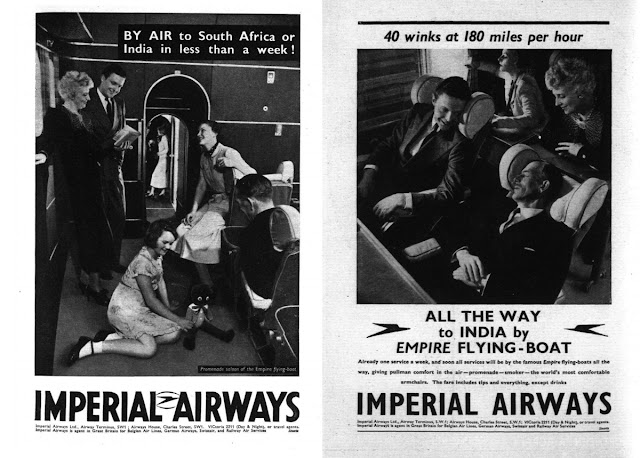Have you been to Rajsamand Lake? It is just an hour north of Udaipur, past the religious centre of Nathdwara.
Rajsamand was built in the 17th century by Raj Singh, the ruler of the Mewar kingdom. Not surprisingly, he named the lake after himself (I like to believe it was not megalomania, but the desire to be permanently remembered for a great dharmik task of religious and social significance).
Raj Singh rather poetically used the word 'samand' (ocean or sea) to describe the lake. If you visit the lake, you will see why. It is a large lake, about 6 kms long, and 3 kms wide, with a depth of 60 feet. In a land-locked state that receives only 1% of India's total rainfall, the lake does seem like an ocean.
Throughout the 18th and 19th centuries, the lake was a blessing to the local populace, for irrigation and as insurance against drought.
But in the late 1920's, Rajsamand suddenly became a very glamorous place. Seaplanes of the Imperial Airways began landing in Rajsamand, on their way from London to Singapore or Sydney. They carried the rich and famous of Europe. After the horrors of WW-I, wealthy Europeans travelled around the world in luxurious seaplanes, celebrating life. It was the Golden Age of Flying Boats. Seaplane flights were long and slow, but offered passengers lots of space, comfortable beds and 5-star service. The all-male cabin crew were usually poached from luxury steamships and knew how to pamper their clientele.
Imperial Airways seaplanes had very little fuel capacity. On a typical trip from London to Sydney, there were 31 stops, and the journey took 16 nights. To make each stop worthwhile, Imperial Airways tried to find lakes that were not just fuelling stations, but also beautiful and exotic. Landing in Rajsamand, passengers were ferried to the shore by boats, and then took the train to Udaipur, where they stayed the night. Meanwhile, the plane refuelled and took in fresh supplies.
The "airport" at Rajsamand had a passenger lounge, a weather station, a wireless station, fuel depots and two residential bungalows. Planes were anchored to the lake (one of the anchors was found a couple of decades ago, when the lake dried up, but it was then tossed back into the water and now no one knows where it is).
For nearly 2 decades, Imperial Airways seaplanes flew into India, stopping at Karachi, Udaipur, Gwalior and Calcutta. In those days, there were not many long runways, so the seaplanes, which could land pretty much anywhere with a nice stretch of water, became hugely popular.

But after WW-II, there were a lot more long runways available in military bases around the world. And there were many military aircraft too, that became available for passenger use.
In nearby Jodhpur, Maharaja Umaid Singh created a small air-strip in the 1920's, which was expanded and used in WW-II by the Royal Air Force (RAF). Umaid Singh himself was a Level A certified flyer, and as Air Vice Marshall, he was in command of the Jodhpur base during the war.
After the war, when passenger flights resumed, Jodhpur became the airport of choice for Imperial Airways, and Rajsamand's glamorous days came to an end.
 |
| Rajsamand Lake, Wikimedia Commons |
Raj Singh rather poetically used the word 'samand' (ocean or sea) to describe the lake. If you visit the lake, you will see why. It is a large lake, about 6 kms long, and 3 kms wide, with a depth of 60 feet. In a land-locked state that receives only 1% of India's total rainfall, the lake does seem like an ocean.
Throughout the 18th and 19th centuries, the lake was a blessing to the local populace, for irrigation and as insurance against drought.
But in the late 1920's, Rajsamand suddenly became a very glamorous place. Seaplanes of the Imperial Airways began landing in Rajsamand, on their way from London to Singapore or Sydney. They carried the rich and famous of Europe. After the horrors of WW-I, wealthy Europeans travelled around the world in luxurious seaplanes, celebrating life. It was the Golden Age of Flying Boats. Seaplane flights were long and slow, but offered passengers lots of space, comfortable beds and 5-star service. The all-male cabin crew were usually poached from luxury steamships and knew how to pamper their clientele.
 |
| Poster for Imperial Airways, |
 |
| Seaplane at Rajsamand |
For nearly 2 decades, Imperial Airways seaplanes flew into India, stopping at Karachi, Udaipur, Gwalior and Calcutta. In those days, there were not many long runways, so the seaplanes, which could land pretty much anywhere with a nice stretch of water, became hugely popular.

But after WW-II, there were a lot more long runways available in military bases around the world. And there were many military aircraft too, that became available for passenger use.
In nearby Jodhpur, Maharaja Umaid Singh created a small air-strip in the 1920's, which was expanded and used in WW-II by the Royal Air Force (RAF). Umaid Singh himself was a Level A certified flyer, and as Air Vice Marshall, he was in command of the Jodhpur base during the war.
After the war, when passenger flights resumed, Jodhpur became the airport of choice for Imperial Airways, and Rajsamand's glamorous days came to an end.